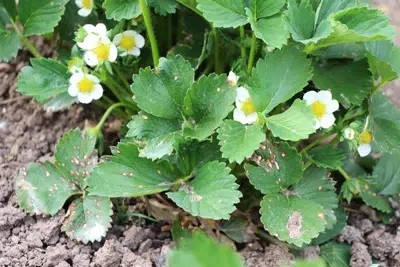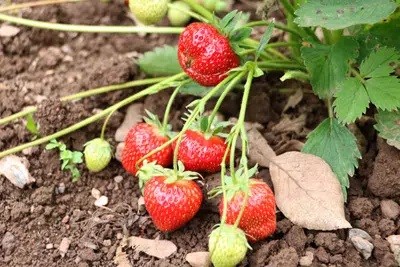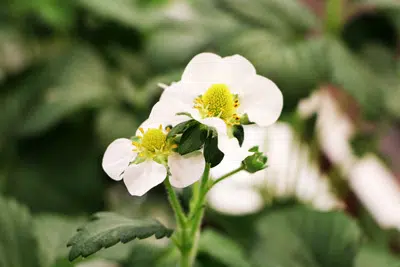There are several reasons why strawberries do not want to bloom, we distinguish here between strawberries planted as seedlings and homegrown strawberries.
Contents
- 1 The following causes may be to blame for the plants refusing to flower:
- 2 errors in care.
- 3 choosing the wrong variety or one that is too sensitive.
- 4 wrong time
- 5 wrong soil
- 6 ground fatigue
- 7 planted too deep
- 8 wrong nutrient supply
- 9 other disturbances of the plant metabolism
- 10 Homegrown strawberries
- 11 wrong parents
- 12 weak offshoots.
- 13 strawberries were grown from seed
- 14 Conclusion
- 15 Author
The following causes may be to blame for the plants refusing to flower:
errors in care.
If you planted strawberries for the first time, perhaps overzealous and insufficiently trained sellers assure you that you only need to put these strawberries in a balcony box, tub, ground. A little water, a little fertilizer, and the delicious fruit will appear as if by itself.
In principle, this is true, but even if you have a slightly different idea of “proper watering” and “proper fertilizing” of strawberries, you can thoroughly upset the plant metabolism. Until the strawberries refuse to bloom. So before planting strawberries, read through strawberry plant care instructions once and follow them carefully for the first strawberries. For example, the article www.gartendialog.de/gartengestaltung/obstgarten/erdbeeren/erdbeerpflanze-setzen.html gives beginners a good overview. If the basic care is correct even after review, there are still plenty of subtleties that can spoil the mood of the strawberries.
choosing the wrong variety or one that is too sensitive.
From the first cross to the “garden strawberry” since the 18th century have been bred more than 1,000 varieties. Varieties for all desires, but they can also develop quite decided requirements. Especially sensitive modern cultivars are far from coping with any normal soil. These strawberry varieties usually develop from parents used in commercial cultivation, where patient, slow selection breeding has been replaced by influencing individual genes. When the infinitely diverse organism “metabolism” is influenced unilaterally, this often shows negative results elsewhere. Even if you were the star in the catalog: a really bitchy modern variety will not grow in soil A and in soil B 10 meters next to it, and you would have to research for a long time to find out the reason.
Remedy: You can move a few more times with the flower-refusing variety; but in the long run, it will certainly be more relaxing and successful if you look among the old hardy strawberry varieties that are now cultivated again by many specialist nurseries}.
wrong time
Plants are planted in the spring? Many plants are, but strawberry plants are not necessarily. Normal strawberry plants are best planted between July and August, so that they can grow well in the warmth of the summer, and after the following winter dormancy next year to start early to form a rich harvest. Strawberries planted in the spring, only under very optimal conditions, still produce a few flowers in the same season, which produce a few measly fruits.
Remedy: Well, it just happened. Take good care of it, hope for a warm summer, maybe in the same season the strawberries will develop at least to the point where you can test the taste of the variety. In the next season, the strawberries will start all the more eager for it. In the spring should be planted only so-called frigo plants, which are overwintered under special physiological conditions: After flowering in the fall, these plants are frozen, and after this artificially prolonged winter, they sprout directly when planted in the spring; nine weeks later, the harvest begins
wrong soil
Strawberries love fresh soil, that is, soil in its ideal state: loose and crumbly, but with enough storage capacity so that the watering water with the nutrients dissolved in it does not flow too quickly past the roots. Soil that compacts easily, e.g. due to a high clay/loam content, or soil that is wet due to its location, causes problems for the roots of the strawberries. If root health is compromised, this can interfere with flower development.
Remedy: Loosen the soil, in soils very prone to compaction or waterlogging, cultivate strawberries on small dams covered with mulch film
ground fatigue
Soil fatigue, long an unfathomable mystery, has tangible causes that have since been researched: This negative change in a cultivated soil is a logical consequence of monocultural soil management. Each plant withdraws nutrients from the soil in a specific composition, which promotes the colonization of certain microorganisms, while others are suppressed. If the one-sided withdrawal is not compensated by plant neighbors of other species, this eventually destroys the ecological balance in the soil. Ecological imbalance weakens soil life, harmful bacteria and fungi and hungry nematodes of expansive species have free rein. Especially rose crops (which include strawberries), quickly cause soil fatigue and therefore should not be grown several times in a row in the same location.
{infobox type=info|content=Remedy: Possibly, soil improvement with rock flour and compost can make the strawberries bloom, also an underplanting or interplanting of soil-nourishing herbs could help. The next strawberries should be planted in another part of the garden (where no apples, pears, blackberries, raspberries, cherries, almonds, plums, roses, hawthorns were or are still growing, because these woody plants all belong to the rose family); all in all, it helps to plant the garden as varied and versatile as possible, crop rotation and mixed culture}.
planted too deep
If strawberries are planted too deep, the metabolism of the plants can not develop properly, can interfere with flowering (shortly after planting).
{infobox type=info|content=Remedy: For the set strawberries difficult, set the next strawberries at the correct height (especially the heart in the middle needs air).}
wrong nutrient supply
The most common reasons for the fact that strawberries somehow grow, but do not bloom, are probably to be found in the wrong supply of nutrients.
Strawberries are heavy feeders, so they need a fairly good supply of fertilizer. If the many leaves grow, but do not look rich green and strong, but rather pale green, flabby, unenthusiastic, there is probably an undersupply of one or more nutrients – the strength is not enough for flower formation. But: also abundance makes sick and unenthusiastic, overfertilization with nitrogen, for example, ensures that the plant grows vigorously, but can not take care of anything else.
Remedy: Fertilizing helps against undersupply, in the right measure and with the right nutrients. Commercially available liquid fertilizer usually contains fast-acting mineral nutrient components that must be dosed very precisely. Against over-fertilization helps to stop the fertilization and possibly interplanting of more abundant herbs. It is easier to ensure an adequate supply of nutrients with organic fertilizer, which is broken down by soil organisms and slowly made available to the plants (in the balcony box organic-mineral fertilizer, because there is not enough soil life to break down purely organic fertilizer

other disturbances of the plant metabolism
When strawberries have to grow in a not very ecological environment, for example, in a “conventionally” (with artificial fertilizers and synthetic pesticides) cultivated garden, the ecological balance in the whole environment often leaves much to be desired. This weakens the plants all around, pests, fungi, further diseases have an easy game. Any pest and fungus that harass strawberries in the natural garden for a while and then disappear without consequences, I can cause serious damage here. For example, weaken the strawberries to the point that they can not develop flowers. Diseases can not be repelled by such strawberries as in the natural garden, but develop and in many cases also ensure that no flowers are developed.
Remedy: Many individual measures can be applied to the currently growing strawberries, directed at the particular damage (symptom). In the long run, the constant symptom control can be avoided only if the whole garden is made more natural (which, however, brings the amateur gardener a significant reduction in work in the ongoing maintenance
Homegrown strawberries
In the case of home-grown strawberries, all the causes just mentioned above can be involved in the strawberries refusing to bloom, but several other reasons come into question:
wrong parents
If you have grown the strawberries yourself from offshoots of a mother plant, you may have nurtured an outgrowth that is not properly viable.
The garden strawberry originated in the 18th century from the accidental crossing of the two American strawberry species Fragaria chiloensis (Chile strawberry) and Fragaria virginiana (Scarlet strawberry). This garden strawberry has thus been bred for over 200 years; as late as the last century, the weaknesses that regularly occur in breeding selections for particular strengths were eradicated through patient breeding until robust varieties were created. Because today the focus is often not on content but on profit, and because novelties promise more profit, a different approach is often taken: Instead of continuing breeding to a viable variety, often even the 1st generation crosses are sold, the so-called F1 hybrids, with which breeding is just beginning for serious breeders.
{infobox type=info|content=Help: If you have purchased the latest breeding star, it is quite possible that it will still form offshoots, but they will not be viable and their strawberries will never develop a flower. You can give the small strawberries some more time, they may just be late developers; if they won’t, next time you should get offshoots from an occupiable or elsewhere visibly robust strawberry variety that is willing to bloom}.
weak offshoots.
If you have taken the offshoots from a mother plant that has already produced healthy, fruiting offspring, the mother plant may already be decrepit. Sometimes it produces a lot of offshoots in order to reproduce in time, but these offshoots are not really viable anymore (in many cultivars not at all, they have already given everything in terms of runners). Or you have chosen the wrong offshoot – if you want to propagate strawberries via offshoots, you should always use only the first plant after the mother plant, because the further offshoots will always be weaker.
strawberries were grown from seed

Raising from seed is also no longer possible for every variety with these plants that have been bred back and forth thousands of times. Seeds obtained from the fruit become fully formed strawberry plants or not; in the case of seed from the purchased bag, all strawberries may germinate, but not all strawberries will be capable of flowering and fruiting; F1 varieties often refuse to form the parts of the plant that are just in the process of formation, even with the slightest impairment.
Help: To be sure of success with seeds, find a nursery that deals with old strawberry plants and ask them to recommend a variety for sowing
Conclusion
Strawberries are only safe to grow easily if you have spent some effort and time selecting the right variety. In the case of sensitive varieties, wait and see will help, and otherwise, perhaps, the optimization of care, but in particularly unfavorable cases, the strawberry will hardly be able to elicit a flower even in the season after next.


